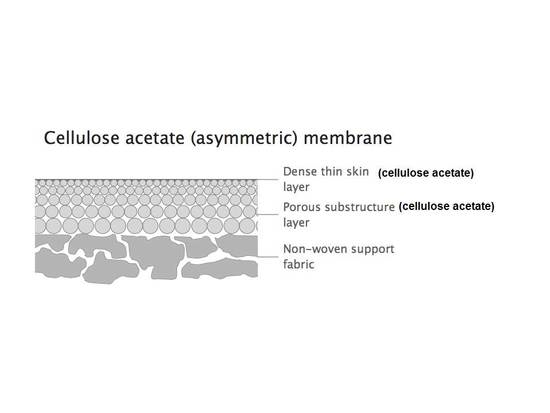Design Next Generation Membranes or Rethink the “Old” Asymmetric Membranes?
Funding
Conflicts of Interest
References
- Loeb, S.; Sourirajan, S. Water demineralization by means of an osmotic membrane. In Saline Water Conversion-II. Advances in Chemistry Series; American Chemical Society: Washington, DC, USA, 1963; Volume 28, pp. 117–132. [Google Scholar]
- Baker, R.W. Membrane Technology and Applications, 2nd ed.; John Wiley and Sons: London, UK, 2004. [Google Scholar]
- Baker, R.W.; Low, B.T. Gas separation membrane materials: A perspective. Macromolecules 2014, 47, 6999–7013. [Google Scholar] [CrossRef]
- Galizia, M.; Chi, W.S.; Smith, Z.P.; Merkel, T.C.; Baker, R.W.; Freeman, B.D. 50th Anniversary Perspective: Polymers and Mixed Matrix Membranes for Gas and Vapor Separation: A Review and Prospective Opportunities. Macromolecules 2017, 50, 7809–7843. [Google Scholar] [CrossRef]
- Baker, R.W.; Lokhandwala, K. Natural gas processing with membranes: An overview. Ind. Eng. Chem. Res. 2008, 47, 2109–2121. [Google Scholar] [CrossRef]
- Yampolskii, Y.; Belov, N.; Alentiev, A. Perfluorinated polymers as materials of membranes for gas and vapor separation. J. Membr. Sci. 2020, in press. [Google Scholar] [CrossRef]
- Golemme, G. Perfluoropolymer membranes for separations and electrochemical processes. In Advanced Materials for Membrane Preparation; Buonomenna, M.G., Golemme, G., Eds.; Bentham EBooks: Sharjah, UAE, 2012; pp. 104–127. [Google Scholar]
- Bondar, V.; Freeman, B.D.; Yampolskii, Y.P. Sorption of gases and vapors in an amorphous glassy perfluorodioxole copolymer. Macromolecules 1999, 32, 6163–6171. [Google Scholar] [CrossRef]
- Merkel, T.C.; Bondar, V.; Nagai, K.; Freeman, B.D.; Yampolskii, Y.P. Gas sorption, diffusion, and permeation in poly (2, 2-bis (trifluoromethyl))-4, 5-difluoro-1, 3-dioxole-co-tetrafluoroethylene. Macromolecules 1999, 32, 8427–8440. [Google Scholar] [CrossRef]
- Merkel, T.C.; Bondar, V.I.; Nagai, K.; Freeman, B.D. Sorption and transport of hydrocarbon and perfluorocarbon gases in poly (1-trimethylsilyl-1-propyne). J. Polym. Sci. Part B: Polym. Phys 2000, 38, 273–296. [Google Scholar] [CrossRef]
- Golemme, G.; Nagy, J.B.; Fonseca, G.; Algieri, C.; Yampolskii, Y.P. 129Xe-NMR study of free volume in amorphous perfluorinated polymers: Comparsion with other methods. Polymer 2003, 44, 5039–5045. [Google Scholar] [CrossRef]
- Buonomenna, M.G. Membrane separation of CO2 from natural gas. Recent Patents Mater. Sci. 2017, 10, 26–49. [Google Scholar] [CrossRef]
- Livingston, A.; Baker, R.W. Membranes from academia to industry. Nat. Mater. 2017, 16, 280–282. [Google Scholar]
- Babu, V.P.; Kraftschik, B.E.; Koros, W.J. Crosslinkable TEGMC asymmetric hollow fiber membranes for aggressive sour gas separations. J. Membr. Sci. 2018, 558, 94–105. [Google Scholar] [CrossRef]
- Achoundong, C.S.K.; Bhuwania, N.; Burgess, S.K.; Karvan, O.; Koros, W.J. Silane Modification of Cellulose Acetate Dense Films as Materials for Acid Gas Removal. Macromolecules 2013, 46, 5584–5594. [Google Scholar] [CrossRef]
- Liu, Y.; Liu, Z.; Liu, G.; Qiu, w.; Bhuwania, N.; Chinn, D.; Koros, W.J. Surprising plasticization benefits in natural gas upgrading using polyimide membranes. J. Membr. Sci. 2020, 593, 117430. [Google Scholar] [CrossRef]
- Park, H.B.; Kamcev, J.; Robeson, L.M.; Elimelech, M.; Freeman, B.D. Maximizing the right stuff: The trade-off between membrane permeability and selectivity. Science 2017, 356, eaab0530. [Google Scholar] [CrossRef] [PubMed] [Green Version]
- Werber, J.R.; Osuji, C.O.; Elimelech, M. Materials for next-generation desalination and water purification membranes. Nat. Rev. Mater. 2016, 1, 16018. [Google Scholar] [CrossRef]
- Cadotte, J.; Petersen, R.; Larson, R.; Erickson, E. A new thin-film composite seawater reverse osmosis membrane. Desalination 1980, 32, 25–31. [Google Scholar] [CrossRef]
- Buonomenna, M.G. Nano-enhanced reverse osmosis membranes. Desalination 2013, 314, 73–88. [Google Scholar] [CrossRef]
- Cohen-Tanugi, D.; Grossman, J.C. Mechanical Strength of Nanoporous Graphene as a Desalination Membrane. Nano Lett. 2014, 14, 6171–6178. [Google Scholar] [CrossRef] [PubMed]
- Yang, Y.; Yang, X.; Liang, L.; Gao, Y.; Cheng, H.; Li, X.; Zou, M.; Ma, R.; Yuan, Q.; Duan, X. Large-area graphene-nanomesh/carbon-nanotube hybrid membranes for ionic and molecular nanofiltration. Science 2019, 364, 1057–1062. [Google Scholar] [CrossRef] [PubMed]
- Lu, X.; Feng, X.; Yang, Y.; Jiang, J.; Cheng, W.; Liu, C.; Gopinadhan, M.; Osuji, C.O.; Ma, J.; Elimelech, M. Tuning the permselectivity of polymeric desalination membranes via control of polymer crystallite size. Nat. Commun. 2019, 10, 2347. [Google Scholar] [CrossRef] [PubMed]

© 2020 by the author. Licensee MDPI, Basel, Switzerland. This article is an open access article distributed under the terms and conditions of the Creative Commons Attribution (CC BY) license (http://creativecommons.org/licenses/by/4.0/).
Share and Cite
Buonomenna, M.G. Design Next Generation Membranes or Rethink the “Old” Asymmetric Membranes? Symmetry 2020, 12, 270. https://doi.org/10.3390/sym12020270
Buonomenna MG. Design Next Generation Membranes or Rethink the “Old” Asymmetric Membranes? Symmetry. 2020; 12(2):270. https://doi.org/10.3390/sym12020270
Chicago/Turabian StyleBuonomenna, Maria Giovanna. 2020. "Design Next Generation Membranes or Rethink the “Old” Asymmetric Membranes?" Symmetry 12, no. 2: 270. https://doi.org/10.3390/sym12020270




